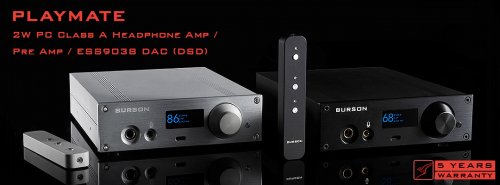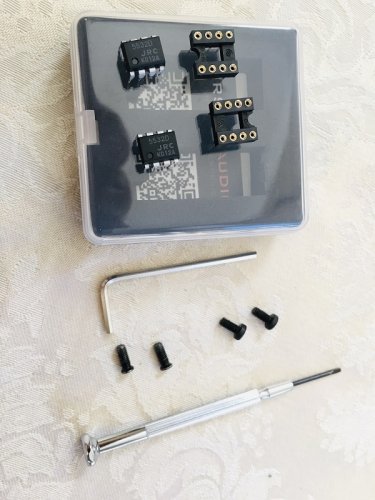Disclaimer:
This HIFIMAN Jade II electrostatic headphone is a unit in an audition tour conducted by HIFIMAN.
I am curious about an electrostatic headphone, so I really appreciate to HIFIMAN team for
this opportunity to try Jade II.


- gear used to compare:
Sabaj D5 -> iFi iCan Pro -> HIFIMan HE-1000 V2

- Look and feel:
. It is in a shape similar to HE-1000 V2 that I own, but lighter in weigth.
. Headband: Jade II has newer headband that has round shape. V2 has flat top.
. both are very conformtable on head, Jade II has aluminum frame without wood veneer,
so I like V2 better on this regard.
. the cable split has been stripped a little bit, which shows the thin wires, makes one
worried about the possible issue from that.
. Amplifier is big and solid design, looks handsome.


- sound stage:
Jade II has great sound stage, it is wider than its depth, it sounds like you are in a music hall.
By comparision V2 sounds like in a smaller room.
Accompanying that incredable sound stage, music image benefited, instruments seem in their
own position and blend in together without interfering each other, on the other hand V2
sound crowded and intimated.
I also noticed Jade II is nature sounding, good layering from different instruments which
are in different volume and in different locations that provide a good sense of the stage.
Listening to Jade II, it is closer to speakers setup than any other headphones that I have
experienced.
- bass:
Jade II bass is there, it can go deep, if you tried Titanic movie sound track 1. Never An Absolution,
the bass can be heard and feel but a tad weak and no extension, it can not compete with
subwoofer speaker (no HP can I believe), comparing with HEK-V2 it is a tad less quantity,
my HEK V2 is driven by iFi iCan pro, and Jade has its own amplifier, so I cannot change gear to
find out if this can be tweaked, that is one of drawback of dedicated amplifier setup.
V2's bass is not great itself comparing with dynamic HP, but I think Jade's bass
can be enhanced a bit, maybe boost it from amplifer, just like iFi iCan pro XBass setting that I use
on my HEK v2 to tweak its bass.
Tried Adele - Rolling in the deep, it is not bad, but if it can punch harder, it would be perfect.
However, with Eagle's Hotel California the bass is still enjoyable.
- mid, high and volcals:
Jade's mid is pleasant to listen, clear and smooth, sounds sweeter than V2, I would descibe is
as a velvet sounding.
Because of its large sound stage, listening to vocal feels recess, this might take some times to
get used to since most heaphones sound closer in. But Jade sounds smooth and clear which makes
all singers, male and female, sound better, and if you are familiar with the singer's voice
chareacters, you may realize that Jade sounds truely for the singers.
Conclusion:
Listen with Jade II is relax and enjoyable. It is the best when listen to a symphony music.
The sound stage makes one feels like it is a live music.
Overall, I think Jade II does everything right, but still there are some areas
that it can be enhanced to do better, such as bass, needs more quantity and quality, and
Headphone cable can be better.
This HIFIMAN Jade II electrostatic headphone is a unit in an audition tour conducted by HIFIMAN.
I am curious about an electrostatic headphone, so I really appreciate to HIFIMAN team for
this opportunity to try Jade II.


- gear used to compare:
Sabaj D5 -> iFi iCan Pro -> HIFIMan HE-1000 V2

- Look and feel:
. It is in a shape similar to HE-1000 V2 that I own, but lighter in weigth.
. Headband: Jade II has newer headband that has round shape. V2 has flat top.
. both are very conformtable on head, Jade II has aluminum frame without wood veneer,
so I like V2 better on this regard.
. the cable split has been stripped a little bit, which shows the thin wires, makes one
worried about the possible issue from that.
. Amplifier is big and solid design, looks handsome.


- sound stage:
Jade II has great sound stage, it is wider than its depth, it sounds like you are in a music hall.
By comparision V2 sounds like in a smaller room.
Accompanying that incredable sound stage, music image benefited, instruments seem in their
own position and blend in together without interfering each other, on the other hand V2
sound crowded and intimated.
I also noticed Jade II is nature sounding, good layering from different instruments which
are in different volume and in different locations that provide a good sense of the stage.
Listening to Jade II, it is closer to speakers setup than any other headphones that I have
experienced.
- bass:
Jade II bass is there, it can go deep, if you tried Titanic movie sound track 1. Never An Absolution,
the bass can be heard and feel but a tad weak and no extension, it can not compete with
subwoofer speaker (no HP can I believe), comparing with HEK-V2 it is a tad less quantity,
my HEK V2 is driven by iFi iCan pro, and Jade has its own amplifier, so I cannot change gear to
find out if this can be tweaked, that is one of drawback of dedicated amplifier setup.
V2's bass is not great itself comparing with dynamic HP, but I think Jade's bass
can be enhanced a bit, maybe boost it from amplifer, just like iFi iCan pro XBass setting that I use
on my HEK v2 to tweak its bass.
Tried Adele - Rolling in the deep, it is not bad, but if it can punch harder, it would be perfect.
However, with Eagle's Hotel California the bass is still enjoyable.
- mid, high and volcals:
Jade's mid is pleasant to listen, clear and smooth, sounds sweeter than V2, I would descibe is
as a velvet sounding.
Because of its large sound stage, listening to vocal feels recess, this might take some times to
get used to since most heaphones sound closer in. But Jade sounds smooth and clear which makes
all singers, male and female, sound better, and if you are familiar with the singer's voice
chareacters, you may realize that Jade sounds truely for the singers.
Conclusion:
Listen with Jade II is relax and enjoyable. It is the best when listen to a symphony music.
The sound stage makes one feels like it is a live music.
Overall, I think Jade II does everything right, but still there are some areas
that it can be enhanced to do better, such as bass, needs more quantity and quality, and
Headphone cable can be better.





























